Reflecta Slide Scanner DigitDia evolution Review
In May 2021 the Germany manufacturer reflecta released a new DigitDia on the market. The new DigitDia evolution, however, does not form a queue with the predecessor series DigitDia 3600, DigitDia 4000, DigitDia 4000b, DigitDia 5000, DigitDia 6000, DigitDia 7000, but is a new development which starts an own line.
The classic magazine scanners, which came on the market in the year 2003 for the first time, are CCD scanners, in which a CCD line sensor samples the films line by line, as we know it from all film scanners up to the highes prices category. The new DigitDia evolution is, in contrary, a CMOS scanner, which photographs the slides like a digital camera. With this property it does not belong to the family of film scanners CrystalScan 7200, ProScan 10T, RPS 10M, DigitDia 7000 but to the family of faster CMOS scanners like x10-Scan, x22-Scan, x33-Scan etc.
CMOS scanners cannot be compared directly with CCD scanners. Earlier we have tested some CMOS scanners from reflecta, see our review on the site Reflecta CMOS scanner, the Reflecta Memo-Scan or the medium format scanner Reflecta X66-Scan. CMOS scanners usually don't achieve the same image quality as CCD scanners. Therefore they are much faster and easier to use.
Equiment and technical data of the DigitDia 7000, Comparison with the DigitDia 7000
The DigitDia evolution does not have a CCD line sensor as its bigger brother DigitDia 7000 but a CMOS sensor, as every digital camera or smart phone has it. The CMOS sensor, which photographs the inserted slides, has 15,3 million pixels and so achieves a resolution you know from your smart phone. With dimensions of maximum 4608 x 3072 Pixeln you receive digital images which contain enough image information for actual screen applications. If you cut the scans a bit in order not to get black edges, you achieve approx. 12 mega pixels per scan. If you compare the rsolution of the DigitDia evolution with the resolution of its bigger brother Reflecta DigitDia 7000, the 15 mega pixels confront 133 mega pixels.
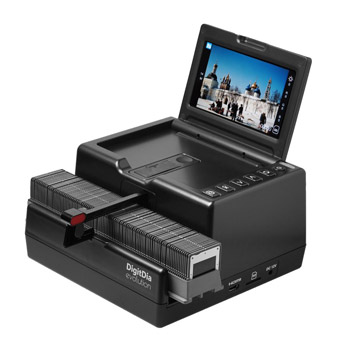
While the DigitDia 7000 samples a slide line by line in high resolution, the DigitDia evolution photographs a slide in a typical digital camera resolution. While a high resolution scan with the DigitDia 7000 takes several minutes the DigitDia evolution takes a photo within a few seconds. The DigitDia 7000 needs a whole day for scanning a complete slide magazine in high resolution; the DigitDia evolution does this job for a magazine with 5o slides in 4 minutes according to the manufacturer.
The DigitDia 7000 is connected to a PC and is operated by the scan software CyberView. As an alternative there is the sophisticated scan software SilverFast from LaserSoft Imaging or VueScan. The DigitDia evolution, in contrary, runs completely independent from a PC as a stand alone device. It has a slot for a SD storage card up to a size of 128 GB, which, however, is not included in the contents of delivery. The control of the scanner is done with a 7"-display, which can be fold open at the top side of the scanner. Thus it becomes clear, that the operation of the scanner is exclusively done with the built-in software; there is no alternative software from other manufacturers.
The DigitDia evolution offers very simple options for the scan settings. A simple exposure correction and colour correction can be done with the display. But more sophisticated settings like tone value curves, gradation curves or special filters, which offer a typical PC software, are not available. The DigitDia evolution stores the scans directly on the SD-card, which you can insert into a card slot of your PC and read it. The scans can be stored only in the compressed JPG format. You neither have options concerning the graphics format nor concerning the compression rate.
The Reflecta DigitDia evolution can process CS magazines, universal magazins and LKM magazines. Paximat magazines, which can process the DigitDia 7000, cannot be inserted into the DigitDia evolution. If you have such magazines you have to put the slides into a different magazine like an universal magazine before scanning.
Wile an automatic dust and scratch removal function is standard at CCD film scanners, such a comfort function is not possible with CMOS scanners. At last, such a scratch and dust removal function samples the slide line by line with an infrared ray and corrects hills (dust) and valleys (scratch) automatically with a software function. When photographing a slide with a CMOS sensor of cours such hills and valleys cannot be detected. Reflecta mentions indeed, that dust and scratches can be eliminated partly thanks to a diffuse LED light source, but this procedure is based rather on an unsharpness effect than on a real detection.
The operation of the DigitDia evolution is done comfortably with the buttons below the display. The only interface, the scanner has, is a HDMI interface, with which you can connect the scanner to a screen or a television device. The scanned slides can be looked at directly at the display of the scanner in form of a slide show. A slide show is also possibly at an external monitor or television, if this is connected to the scanner with the HDMI interface.
If you study the technical data of the scanner you immediately realize, that the reflecta DigitDia evolution is not successor of the well proven DigitDia 7000, but an alternative model, which is optimized on speed and simplicity. The DigitDia evolution can digitize large amounts of slides in the JPG format very quickly. Sophisticated setting options, as they are offered from a PC scan software of CCD scanners, are not available. Furthermore a colour calibration with the help of IT-8 targets, as it is usually possibly for film scanners with PC control, are not available for the DigitDia evolution.
The Reflecta DigitDia evolution can digitize lots of slides in a simple image quality in a very short time. Special setting and selection possibilities, which a common PC software offers, are not available in the integrated software of the DigitDia evolution.
Set up and scanning with the reflecta DigitDia evolution
For the use of the DigitDia evolution neither a PC nor a scan software is necessary. You only need current and a SD card for storing the scans. There are SD-cards and SDHC-cards upt a size of 128 GB supported. You connect the included power cable with the scanner and a sucket, you insert your storage card into the card slot and now the DigitDia evolution is already ready to start.
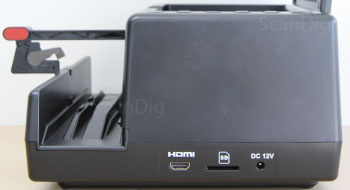
You can flap up the 7 inch screen in the middle of the device and by pressing the power button you will be greezed with the company logo and the model name. Now the control LED lights permanently blue and a note appears on the display that this device is built only for private use and not for commercial use. You can navigate within the menu using the arrow keys. In the main menu there are sub menus for language, scan mode, resolution, scanning, image section, slide show and formatting the SD card. By pressing OK you get into the coressponding sub menu. The DigitDia evolution can be operated in 5 languages: German, English, French, Italian, Spanish. You can select the resolution between the two values 14 Megapixels and 22 MP.
Just because the DigitDia evolution does not contain a function for automatic scratch and duest removal, you should clean your slides before you insert the magazine into the scanner. At least you should clean them from mayor dust particles by blowing the whole magazine with a anti dust spray.
If you are willing to use more time for the cleaning of your slides, we recommend to use a anti static brush, with which you can remove much more dust than just with compressed air.
While the DigitDia 7000 can digitize mounted slides both in portrait format, landscape format and even full format slides with an image area of 36x36mm the DigitDia evolution only knows the landscape format. Thus you have to rotate all slides in the magazine into the landscape format. For the right orientation of a scan the slides have to be head up with the film site on the right side, in direction of case nomber 1. After scanning you have to rotate portrait format slides within an image editing software.
The Reflecta DigitDia evolution scans slides only in the landscape format. You have to rotate slides in the portrait format before scanning in the magazine.
You shift the slide magazine from left to right into the slot, starting with case nomber 1. The slide pusher should be inside the device, and so you can shift the magazine till the stop to the slide shifter. If you want to transport forward the magazine manually you pull out the slide shifter and shift it in again. By this movement the magazine is moved by one slide position each time. If you want to scan slides automatically, you select the the point "scan-mode" in the menu and choose the option "slide magazine". Subsequently the capacity of the magazine is asked. You can select between 36, 40, 50, 60, 80 and 100. By pressing the OK button the illumination area of the scanners appears. You should check before scanning if it is clean.

If you detect dust and dirty particles you may clean the illumination field with the brush, which is included in the content of delivery. For doing this you open the gum flap on the slide lift at the top site of the scanner and enter the cleaning stick with the brushes to the left side into the scanner. You can monitor the cleaning procedure in real time on the display. In order to start the scan you press the scan buttom at the device. During the scan procedure the blue LED status LED blinks for a moment at each slide. At the end of the batch scan the LED blinks read and by pressing the home button you get back to the main menu. If the magazine is not fully charged, for instance because there are gaps beween the slides or you just have 30 instead of 36 slides in the magazin, the control LED blinks for a moment in pink and no emtpy scan is done. Rathermore the scannner proceeds to the next position until it has achieved the entered nomber of slides in the magazine.
Digitizing mounted slides with different magazines
As its CCD predecessors the reflecta DigitDia evolution is compatible with different magazine types. Since the scanner is specialized on scanning mounted 35mm slides with exterior dimensions of 5x5cm for landscape format only, it is not possible to digitze other film types with this scanner. So you cannot scan 35mm film strips or full format 35mm slides with it.The slide mounts maybe out of cardbox, plastics or aluminum with a maximum thickness of 3,2mm, with our without glass windows. Furthermore the manufacter indicates in the manual that the DigitDia evolution is not suitaable for frameless full format glass slides, which just consist of two glass plates glued to each other.
According to the manufactuer the DigitDia evolution is compatible with the following magazine types:
- CS magazines
- Universal magazines (DIN 108)
- LKM-magazines (Leica-Kindermann magazines)
With these allmost all usual magazine types can be processed. If your slides are archived in a different way you have to sort them into one of these magazines before scanning. As for slide projectors a prerequisition for a fluent transport of the slides is that the slide mounts are neither curved nor damaged in any way, since basically the transport of ths slide mounts with the DigitDia evolution works in the same way as a slide projector or the CCD predecessors of the DigitDia series.
If you scan slides in universal magazines you have to put the lever at the slide pusher down, in order to achieve a wider contact area for the slide shifter. For all other magazine types this selection lever remains in the upper position. Via the slide lift with the cleaning opening you can also scan singular slide mounts without magazines.
Since the Reflecta DigitDia Evolution works like a slide projector with a digital camera, which photographs the slides, you can process only positives with this scanner. Thus the DigitDia Evolution cannot digitize framed negatives
Slide show with the DigitDia evolution
The DigitDia evolution is not only suitable for digitizing slides directly from slide magazines but also can be used as a digital slide viewer. You can watch the slides either with the integrade 7" screen or by connecting the scanner via HDMI to a television/monitor/beamer. In the main menu you can find the item "slide show". Here you can first select if you want to see slides or scans (from SD card). Then you have the possibility between an automatic and a manual play. Within the manual playback you can select a playback duration in steps of 3s, 5s, 10s, 15s, 20s and 30s. You start the playback with the OK button. By pressing HOME you can interrupt the slide show any time and you get back to the main menu.
While slide projectors which have prooved over decades are not available any more these days, with the reflecta DigitDia Evolution there is possibility to watch slides directly from the magazine at a television or with the help of a beamer on a screen, without the need of a PC for it. Thus the DigitDia evolution replaces a slide projector in a wide sense.
Since the DigitDia Evolution only knows the landscape format, portrait format images have to be rotated manually before viewing them. During the slide show they will be displayed retatedly, of course.
The image quality of the reflecta DigitDia evolution
Let us start with the resolution of the scanner. The scan of a 35mm positive (3,6 x 2,4 cm) yields an image file with 4584 x 3056 pixels at the resolution of 14 mega pixels according to the manufacturer. We check this by making a resolution test with a USAF 1951 target (see our website to the topic resolution):

At a scan with the highest possible resolution of 14 megapixels we just can see the vertical lines of the element 5.3 and the horizontal lines of the element 5.3. According to the USAF resolution test table these value correspond to about 2050 ppi. If one scans a 24x36 mm slide with 2050 ppi one gets an image file with about 1959 x 2928 pixels. This corresponds to about 5,7 million pixel. Compared to the nominal resolution of 14 mega pixels this means, taht the reflecta DigitDia evolution achieves effectively about 41% of the nominal resolution.A 35mm slide which was made with a very good camera and very good lense includes about 20 million pixels of image information; when scanning such a slide the DigitDia Evolution takes just a bit less than a third out of the film. At film material, produced with a simple camera - lense - combination this quote is a bit better, of course.
The Reflecta DigitDia scans nominally with a resolution of 14 millionen pixels. It achieves effectively approx. 5,7 megapixel, which corresponds to an effective resolution of about 2050 ppi.
5,7 million pixels suffice completely in order to watch an image at the monitor. Even if you watch the image at an HDMI-television there are more pixels available than the television can display. For high-value prints or for presentations with 4k-displays this nomber of pixels is, hwoever, too low. While the gib brother Reflecta DigitDia 7000 takes more than 30 million pixels out of a 35mm slide, which means that it samples all image points which are included in the film, even in a high resolved Kodachrome film, the almost 6 Megapixel of the Reflecta DigitDia evolution are too few in order to digitize a film really completely.
If we look at the colours reproduction of the Reflecta DigitDia evolution and compare it with the bigger brother DigitDia 7000, we always have to keep in mind the result of our resolution test: The DigitDia 7000 achieves thanks to its higher nominal and effective resolution of course a much sharper scan than the DigitDia evolution. However, we will not evaluate the sharpness any more in the following tests.
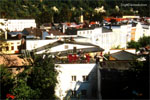
Our first scan shows the change of the scans of a village image, once with the DigitDia evolution and once with the DigitDia 7000. Of course you notify immediately that the DigitDia 7000 produces a sharper image. But the scan is not only sharper but also has more contrast. Especially at the house front you can recognize at the scan of the DigitDia evolution, that there are hardly singular colours detectable. The bright areas of the image are significantly over exposed while the other darnk parts loose contrast.
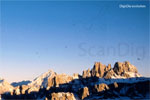
Our second image shows the cutout of a mountain panorama in the Alps. the Der DigitDia evolution gets along with this image, which does not have a high contrast range, and delivers a good scan. With this slide, which is pretty old, you immediately recognize the missing possibility to remove dust and scratches automatically with the DigitDia evolution. The film is dirty, some dust particales are on the surface of the film. The DigitDia 7000 has additionally to the 3 colour channels red, green and blue an infrared channel with which the surface of the film is sampled. At these positions where the infrared channel measures an elevation a dust particle will be detected and this part of the image will be corrected with the surrounding image information. Thus the sky covered with spots becomes almost a clear blue summer sky.
Everybody has to decide on its own if one wants to use such an automatic image correction. Of course an image with a spot free sky seems to be more perfect that a sky with spots. But that is the film, and in this way it was seen in earlier times, e.g. at a screen. A CD also sounds more perfectly and clearer than an old vinyl disk; but for many music enthusiasists the warm noise of a vinyl disk still belongs to the music.
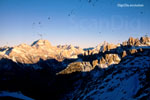
Our third example also shows a mountain panorama shot. This film is contained in a dirty glass frame. Here you can see, too, how a scanner with MagicTouch, the automatic dust and scratch correction function of the reflecta, removes automatically the dust spots, while the DigitDia evolution scans them without consideration. And here we leave it again to the reader to decide on his own which the better scan is. In terms of colours both scans are good.
If you feel disturbed by the dust and scratches of the DigitDia evolution you should clean your slides carefully before scanning. With an anti dust spray you can remove a lot of dust from the slides. You can remove fine and persistent dust with an anti static brush. You can clean dirty glass frames like in our third example with a special cleaning liquid for optical glasses without producing smear on the glass. ANd of course you also can remove disturbing spots after scanning in the image editing software.
Our examples show clearly that the reflecta DigitDia evolution provides scans in good quality. An automatic dust and scratch correction which the bigger brother DigitDia 7000 has is missing however.
The missiont automatic dust and scratch removal function of the DigitDia evolution is always noticable if you have bright image areas like at a sky or at an interior wall. In images within a city or the nature the spots disappear in the darker image areas.
The DigitDia Evolution produces scans only in the compressed JPG format, i.e. it can save images only in the compressed form. It is known that quality losses rise ab at the JPG compression. It would be nice, if the manufacturer would add the uncompressed TIF format as output format one day.
The scan speed of the reflecta DigitDia evolution
Compared to a CCD scanner a CMOS scanner is a speed miracle. Even if this is not the main criteron at a magazine scanner, which is built to digitize a large amount of mounted slides in the batch mode. Finally the scanner is supposed to digitize alle slides within a magazin after inserting it without do any action.
In order to find out how fast the DigitDia evolution really is we took our stopwatch for our test report. Since the SD storage card has a major influence on the total speed we mention here that for our test we used a SanDisk Ultra SDHC card with 30MB/s.
| Process |
|
| Preview of a mounted slide |
Real time |
| Scan of a slide |
0:02 min |
| Scan of a 36 magazine |
2:55 min |
| Scan of a 50 magazine |
3:54 min |
| Scan of a 100 magazine |
7:48 min |
Conclusion of our speed test: The DigitDia evolution is really fast. You can digitize a magazine with 100 mounts in less than 10 minutes including starting the scanner. This sounds amazing at the first glance, because in this way a complete slide collection can be scanned at a rainy afternoon. However, these scan times the DigitDia evolution can only achieve if the magazine runs through without interruption.
In our tests we noticed that this depends on the magazine types and the slides. Sometimes the scanner didn't work at all with some magazines without seeing an abvious reason. Somethis it showed an arror message every 2-3 scans. Sometims a whole magazine ran through without interruption. It seems that a bit of luck is needed to scan one's magazines without problemes.
Conclusion, summary
The DigitDia evolution is a very fast device which photographs mounted 35mm slides in the landscape format (only) directly from the magazine and stores the image files in the JPG format on an SD card. The device is so fast that you can use it both for scanning the slides and for just viewing the slides. Whilst the former magazine scanners from reflecta were able to digitize both portrait and landscape slides, the DigitDia Evolution only knows the landscape format. Thus you cannot just insert a magazine and let it run through, but you have to rotate the portrait slides into the landscape format manually.
The DigitDia evolution yields acceptable scans, whose resolution and colour quality is sufficient for typical monitor applications and display presentations. Its biggest deficit is the missint automatic dust and scratch correction function, which is standad in the film scanner area nowadays. For a final archiving of mounted 35mm slides it retrieves too fes image information out of the films.
Back to the film scanner tests index
|